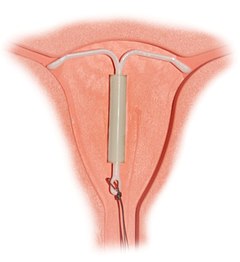ଆଇୟୁଡି ଉଇଥ ପ୍ରୋଜେସ୍ଟେରନ
ଆଇୟୁଡି ଉଇଥ ପ୍ରୋଜେସ୍ଟେରନ (ଇଂରାଜୀ ଭାଷାରେ Intrauterine device (IUD) with progestogen, ବିକ୍ରୟ ନାମ ମିରେନା/Mirena ଏକ ଅନ୍ତଃଜରାୟୁ ଉପକରଣ (intrauterine device) ଯେଉଁଥିରୁ ଲେଭୋନୋରଜେସ୍ଟ୍ରେଲ (levonorgestrel) ହରମୋନ ନିର୍ଗତ ହୁଏ ।[୨] ଜନ୍ମ ନିରୋଧ ଓ ଅତ୍ୟଧିକ ଋତୁସ୍ରାବ (heavy menstrual periods) ଚିକିତ୍ସା ତଥା ଏସ୍ଟ୍ରୋଜେନ ରିପ୍ଲେସମେଣ୍ଟ ଥେରାପି (estrogen replacement therapy) ଜନିତ ଏଣ୍ଡୋମେଟ୍ରିଆଲ ହାଇପରପ୍ଲାସିଆ (excessive build of the lining of the uterus) ରୋଗର ପ୍ରତିଷେଧ ନିମନ୍ତେ ବ୍ୟବହାର କରାଯାଏ ।[୨] ଏହା ଏକ ପ୍ରଭାବଶାଳୀ ଜନ୍ମ ନିରୋଧକ ଯେଉଁଥିରେ ଏକ ବର୍ଷର ଫେଲ ହାର ମାତ୍ର ୦.୨% ।[୧] ଏହି ଉପକରଣ ଜରାୟୁ ( uterus) ମଧ୍ୟରେ ରଖାଯାଏ ଯାହା ୩ରୁ ୫ବର୍ଷ ପର୍ଯ୍ୟନ୍ତ କାମକରେ ।[୩] ଏହି ଉପକରଣ କାଢ଼ିନେଲାପରେ ଗର୍ଭଧାରଣ କ୍ଷମତା (fertility) ଫେରିଆସେ ।[୨]
| ଆଇୟୁଡି ଉଇଥ ପ୍ରୋଜେସ୍ଟେରନ | |
|---|---|
 Correctly inserted IUD | |
| Background | |
| Type | Intrauterine |
| First use | 1990 (Mirena—currently available) 1976 (Progestasert—discontinued in 2001) |
| Synonyms | intrauterine system (IUS), levonorgestrel intrauterine system |
| Trade names | Kyleena, Liletta, Mirena, Skyla, others |
| AHFS/Drugs.com | |
| Failure rates (first year) | |
| Perfect use | 0.2%[୧] |
| Typical use | 0.2%[୧] |
| Usage | |
| Duration effect | 5-7 years (Mirena), 3 years (Skyla) |
| Reversibility | 2–6 months |
| User reminders | Check thread position monthly |
| Advantages and disadvantages | |
| STI protection | No |
| Periods | Menstrual irregularity, periods usually lighter or none at all |
| Weight | Potential side effect |
| Benefits | No need to remember to take daily action |
| Risks | benign ovarian cysts, transient risk of PID, uterine perforation (rare) |
ଅନିୟମିତ ଋତୁସ୍ରାବ, ଓଭାରିଆନ ସିସ୍ଟ (ovarian cysts), ପେଲଭିସ ଯନ୍ତ୍ରଣା ଓ ଅବସାଦ ଆଦି ପ୍ରତିକ୍ରିୟା ଏହି ଔଷଧ ଯୋଗୁ ଦେଖାଯାଇପାରେ ।[୨] କ୍ୱଚିତ ଜରାୟୁ ଛିଦ୍ର (uterine perforation) ମଧ୍ୟ ହୋଇପାରେ । [୨] ଗର୍ଭାବସ୍ଥାରେ ଏହା ଦିଆଯାଏନାହିଁ କିନ୍ତୁ ସ୍ତନ୍ୟପାନ ସମୟରେ ନିରାପଦ ଜଣାଯାଏ ।[୨] ଏହା ଏକ ପ୍ରକାର ଦୀର୍ଘ-କାର୍ଯ୍ୟକ୍ଷମ ଜନ୍ମ ନିରୋଧକ (long-acting reversible birth control) ।[୪] ଏହା ଜରାୟୁଗ୍ରୀବାର ଝିଲ୍ଲି (mucous) ମୋଟା କରିଦିଏ ଯାହାଦ୍ୱାରା ଏଣ୍ଡୋମେଟ୍ରିଅମ (lining of the uterus) ବୃଦ୍ଧି ହୋଇପାରେନାହିଁ ଓ ବେଳେବେଳେ ଡିମ୍ବକ୍ଷରଣ (ovulation) ବନ୍ଦ ହୋଇଯାଏ । [୨]
ଫିନଲାଣ୍ଡରେ ସନ ୧୯୯୦ରେ ଓ ଯୁକ୍ତରାଷ୍ଟ୍ର ଆମେରିକାରେ ସନ ୨୦୦୦ରେ ଡାକ୍ତରୀ ବ୍ୟବହାର ନିମନ୍ତେ ଆଇୟୁଡି ଉଇଥ ପ୍ରୋଜେସ୍ଟେରନ ସ୍ୱୀକୃତ ହୋଇଥିଲା ।[୫] ଏହାର ନାମ ବିଶ୍ୱ ସ୍ୱାସ୍ଥ୍ୟ ସଂଗଠନର ଅତ୍ୟାବଶ୍ୟକୀୟ ଔଷଧ ଚିଠାରେ (World Health Organization's List of Essential Medicines) ଅଛି ଯାହା ମୌଳିକ ସ୍ୱାସ୍ଥ୍ୟ ସିସ୍ଟମ (health system) ନିମନ୍ତେ ଅତି ମହତ୍ତ୍ୱପୂର୍ଣ୍ଣ ।[୬] ବିକାଶଶୀଳ ଦେଶମାନଙ୍କରେ (developing world) ଏହି ଔଷଧର ପ୍ରତ୍ୟେକ ଡୋଜର ମୂଲ୍ୟ ୧୨୨.୪୬ ଆମେରିକୀୟ ଡଲାର ।[୭] ସଂଯୁକ୍ତ ରାଷ୍ଟ୍ରରେ ଏହାର ମୂଲ୍ୟ ୮୮ ପାଉଣ୍ଡ ।[୨] ଯୁକ୍ତରାଷ୍ଟ୍ର ଆମେରିକାରେ ଏହାର ମୂଲ୍ୟ ୮୪୪ ଆମେରିକୀୟ ଡଲାର ।[୮] ଶହେ କୋଡ଼ିଏରୁ ଅଧିକ ଦେଶରେ ଏହାର ବ୍ୟବହାର ସ୍ୱୀକୃତ ହୋଇଛି ଓ ଏହା ୧୦ ନିୟୁତ ମହିଳା ବ୍ୟବହାର କରୁଛନ୍ତି ।[୫][୯]
ଆଧାର
ସମ୍ପାଦନା- ↑ ୧.୦ ୧.୧ ୧.୨ Trussell, James (2011). "Contraceptive efficacy". In Hatcher, Robert A.; Trussell, James; Nelson, Anita L.; Cates, Willard Jr.; Kowal, Deborah; Policar, Michael S. (eds.) (eds.). Contraceptive technology (20th revised ed.). New York: Ardent Media. pp. 779–863. ISBN 978-1-59708-004-0. ISSN 0091-9721. OCLC 781956734.
{{cite book}}:|editor6-first=has generic name (help) Table 26–1 = Table 3–2 Percentage of women experiencing an unintended pregnancy during the first year of typical use and the first year of perfect use of contraception, and the percentage continuing use at the end of the first year. United States. Archived 2013-11-12 at the Wayback Machine. - ↑ ୨.୦ ୨.୧ ୨.୨ ୨.୩ ୨.୪ ୨.୫ ୨.୬ ୨.୭ British national formulary: BNF 69 (69th ed.). British Medical Association. 2015. p. 556. ISBN 9780857111562.
- ↑ "Levonorgestrel intrauterine system medical facts from Drugs.com". www.drugs.com. Retrieved 1 January 2017.
- ↑ Wipf, Joyce (2015). Women's Health, An Issue of Medical Clinics of North America,. Elsevier Health Sciences. p. 507. ISBN 9780323376082.
- ↑ ୫.୦ ୫.୧ Bradley, Linda D.; Falcone, Tommaso (2008). Hysteroscopy: Office Evaluation and Management of the Uterine Cavity. Elsevier Health Sciences. p. 171. ISBN 0323041019.
- ↑ "WHO Model List of Essential Medicines (19th List)" (PDF). World Health Organization. April 2015. Retrieved 8 December 2016.
- ↑ "IUD (Levonorgestrel)". International Drug Price Indicator Guide. Retrieved 8 December 2016.[permanent dead link]
- ↑ Zieman, Mimi. "Chapter 27". Managing Contraception 2012–2014. Managing Contraception. ISBN 9781467536400.
- ↑ Schäfer-Korting, Monika (2010). Drug Delivery. Springer Science & Business Media. p. 290. ISBN 9783642004773.